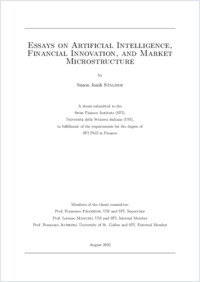Essays on artificial intelligence, financial innovation, and market microstructure
- Stalder, Simon Janik
- Franzoni, Francesco (Degree supervisor)
- 2025
PhD: Università della Svizzera italiana
English
This dissertation comprises three distinct chapters. Each of them leverages modern quantitative methods to investigate different aspects of information in financial markets. The first chapter presents an innovative method for measuring uncertainty via large language models (LLMs), which offer greater precision and contextual sensitivity than the conventional methods used to construct prominent uncertainty indices. By analysing newspaper texts with state-of-the-art LLMs, our approach captures nuances often missed by conventional methods. We develop indices for various types of uncertainty, including geopolitical risk, economic policy, monetary policy, and financial market uncertainty. Our findings show that shocks to these LLM-based indices exhibit stronger associations with macroeconomic variables, shifts in investor behaviour, and asset return variations than conventional indices, underscoring their potential for more accurately reflecting uncertainty. The second chapter examines the role of major Bitcoin exchanges in price discovery. Using high-frequency trade data from spot and perpetual futures markets involving fiat currencies and stablecoins, we identify spot and perpetual futures on the less-regulated exchange Binance as the primary source of price discovery. We show that lower transaction costs and higher trading volumes significantly enhance price discovery. Additionally, we analyse intraday dynamics and find that the more regulated spot exchanges, such as Coinbase, become relatively more influential during the New York 4 pm fixing. These findings highlight regulatory challenges, as Bitcoin prices used in products like ETFs are largely determined on exchanges potentially susceptible manipulation. The third chapter investigates dollar dominance in foreign exchange trading in a market microstructure setting. 88% of all transactions in the foreign exchange market involve the US dollar (USD), largely due to its role as a vehicle currency: Traders often route trades through the USD to access better liquidity. We develop a novel methodology to identify USD cross-trades using high-frequency data from the two primary interdealer platforms. Our analysis shows that cross-trades drive significant price variation in exchange rates. Using an instrumental variable approach, we find that increased cross-trading causes higher USD volatility. This highlights a trade-off: While dollar dominance enhances liquidity, it also exposes the USD to global uncertainty.
- Collections
- Language
-
- English
- Classification
- Economics
- License
-
License undefined
- Open access status
- green
- Identifiers
-
- NDP-USI 2025ECO005
- ARK ark:/12658/srd1332575
- URN urn:nbn:ch:rero-006-123084
- Persistent URL
- https://n2t.net/ark:/12658/srd1332575
Statistics
Document views: 122
File downloads:
- 2025ECO005: 261
